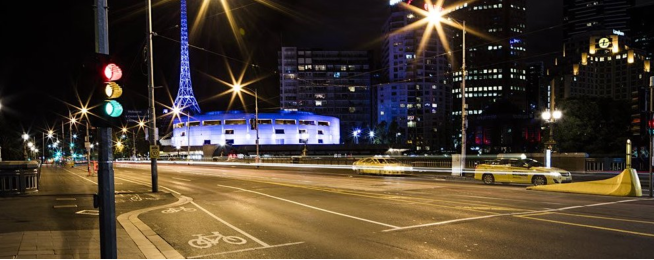New technology that better detects bike riders and pedestrians at intersections is being introduced to Melbourne.
High-definition camera sensors that detect riders and walkers in real time are being installed at 75 intersections.
The system not only eliminates the need to press the button but will also measure how many people are waiting to cross or are already crossing.
This new hardware is mounted on existing traffic lights and uses infra-red or high-definition video detectors facing the road pedestrians and riders are crossing.
The project is part of the $340 million Smarter Roads program that will upgrade road management systems across Melbourne west, east and south-east.
The sensors will also for the first time collect data on traffic patterns at crossings that can be used to better plan traffic signal operation.
The advanced crossing software can sense how many pedestrians are waiting to cross and adapts the crossing time depending on the size of the group.
This reduces wait times for pedestrians by allowing people to move more frequently when a large group is detected. It also reduces the risk of pedestrians spilling out on to the roadway if it is a particularly busy crossing.
Drivers could also benefit. Normally pedestrian crossings are pre-programmed at locations like schools for pick-up and drop-off times, but sometimes these programmed crossing times are in place during school holidays causing drivers’ unnecessary delays.
The Smarter Roads program goes far beyond the sensors at intersections project.
Some 691 CCTV traffic monitoring cameras, 200 wireless travel time sensors and 40 live travel signs will be installed.
And multiple air quality sensors are also being rolled out at roadside.
In total 152 new specialist staff will join VicRoads, including specialist congestion managers, signals engineers, data scientists, user experience specialists
When incidents such as collisions gum up the network, road managers can intervene in real time, adjusting traffic signals at multiple intersections.
The largest review of traffic light sequencing ever conducted in Melbourne is also underway to keep people and freight moving—759 traffic lights at 170 intersections across three traffic hot spots in Melbourne’s East, South East and West will be analysed and updated to optimise traffic.
While there is a risk that schemes designed to improve traffic flow can reduce the performance of bike routes, the Smarter Roads initiative is required to adhere to bike prioritisation as established under the Department of Transport Movement and Place policies.
Become our friend
Find out more about Bicycle Network and support us in making it easier for people to ride bikes.


